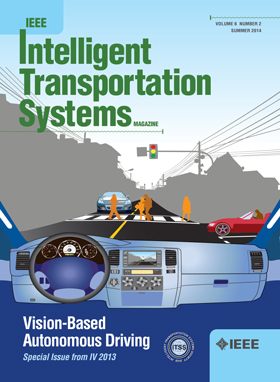Safety-Quantifiable Line Feature-Based Monocular Visual Localization With 3D Prior Map
IF 8.4
1区 工程技术
Q1 ENGINEERING, CIVIL
IEEE Transactions on Intelligent Transportation Systems
Pub Date : 2025-06-02
DOI:10.1109/TITS.2025.3572620
引用次数: 0
Abstract
Accurate and safety-quantifiable localization is of great significance for safety-critical autonomous systems, such as Autonomous ground vehicles (AGVs) and autonomous aerial vehicles (AAVs). The visual odometry-based method can provide accurate positioning in a short period but is subject to drift over time. Moreover, the quantification of the safety of the localization solution (the error is bounded by a certain value) is still a challenge. To fill the gaps, this paper proposes a safety-quantifiable line feature-based visual localization method with a prior map. The visual-inertial odometry provides a high-frequency local pose estimation, which serves as the initial guess for the visual localization. By obtaining a visual line feature pair association, a foot point-based constraint is proposed to construct the cost function between the 2D lines extracted from the real-time image and the 3D lines extracted from the high-precision prior 3D point cloud map. Moreover, a global navigation satellite system (GNSS) receiver autonomous integrity monitoring (RAIM) inspired method is employed to quantify the safety of the derived localization solution. Among that, an outlier rejection (also well-known as fault detection and exclusion) strategy is employed via the weighted sum of squares residual with a Chi-squared probability distribution. A protection level (PL) scheme considering multiple outliers is derived and utilized to quantify the potential error bound of the localization solution in both position and rotation domains. The effectiveness of the proposed safety-quantifiable localization system is verified using the datasets collected by AAV and AGV in indoor and outdoor environments, respectively. The open-source code is available at基于安全可量化线特征的三维先验地图单目视觉定位
准确且可安全量化的定位对于自主地面车辆(agv)和自主飞行器(aav)等安全关键型自主系统具有重要意义。基于视觉里程计的方法可以在短时间内提供准确的定位,但随着时间的推移会发生漂移。此外,定位解的安全性的量化(误差有一定的限定值)仍然是一个挑战。为了填补这一空白,本文提出了一种基于先验地图的安全可量化的线特征视觉定位方法。视觉惯性里程计提供高频局部姿态估计,作为视觉定位的初始猜测。通过获取视觉线特征对关联,提出一种基于足点的约束,构建实时图像中提取的二维线与高精度先验三维点云图中提取的三维线之间的代价函数。此外,采用全球导航卫星系统(GNSS)接收机自主完整性监测(RAIM)启发方法对导出的定位解的安全性进行量化。其中,采用了一种异常值抑制(也称为故障检测和排除)策略,通过加权残差平方和与卡方概率分布。推导了一种考虑多离群点的保护水平(PL)方案,并利用该方案量化了定位解在位置域和旋转域的潜在误差界。利用AAV和AGV分别在室内和室外环境中收集的数据集验证了所提出的安全量化定位系统的有效性。其开源代码可从https://github.com/ZHENGXi-git/SafetyQuantifiable-PLVINS获得
本文章由计算机程序翻译,如有差异,请以英文原文为准。
求助全文
约1分钟内获得全文
求助全文
来源期刊

IEEE Transactions on Intelligent Transportation Systems
工程技术-工程:电子与电气
CiteScore
14.80
自引率
12.90%
发文量
1872
审稿时长
7.5 months
期刊介绍:
The theoretical, experimental and operational aspects of electrical and electronics engineering and information technologies as applied to Intelligent Transportation Systems (ITS). Intelligent Transportation Systems are defined as those systems utilizing synergistic technologies and systems engineering concepts to develop and improve transportation systems of all kinds. The scope of this interdisciplinary activity includes the promotion, consolidation and coordination of ITS technical activities among IEEE entities, and providing a focus for cooperative activities, both internally and externally.
 求助内容:
求助内容: 应助结果提醒方式:
应助结果提醒方式:


